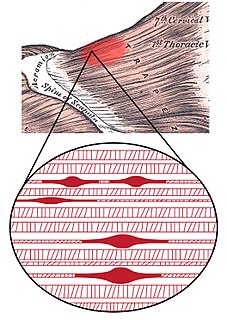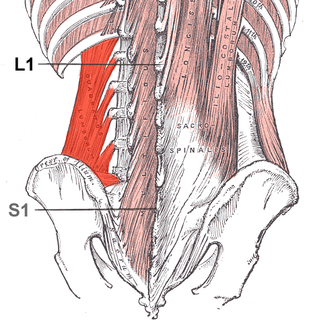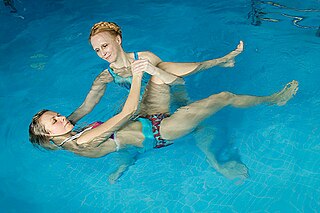Related Research Articles

Temporomandibular joint dysfunction is an umbrella term covering pain and dysfunction of the muscles of mastication and the temporomandibular joints. The most important feature is pain, followed by restricted mandibular movement, and noises from the temporomandibular joints (TMJ) during jaw movement. Although TMD is not life-threatening, it can be detrimental to quality of life; this is because the symptoms can become chronic and difficult to manage.

Massage is the manipulation of the body's soft tissues. Massage techniques are commonly applied with hands, fingers, elbows, knees, forearms, feet, or a device. The purpose of massage is generally for the treatment of body stress or pain. In European countries, a person professionally trained to give massages is traditionally known as a masseur (male) or masseuse (female). In the United States, these individuals are often referred to as massage therapists, because they must be certified and licensed as "Licensed Massage Therapists".

Osteopathy is a type of alternative medicine that emphasizes physical manipulation of the body's muscle tissue and bones. Practitioners of osteopathy are referred to as osteopaths. Its name derives from Ancient Greek ὀστέον (ostéon) 'bone', and πάθος (páthos) 'pain, suffering'.
Spasticity is a feature of altered skeletal muscle performance with a combination of paralysis, increased tendon reflex activity, and hypertonia. It is also colloquially referred to as an unusual "tightness", stiffness, or "pull" of muscles.

Torticollis, also known as wry neck, is a dystonic condition defined by an abnormal, asymmetrical head or neck position, which may be due to a variety of causes. The term torticollis is derived from the Latin words tortus for twisted and collum for neck.
Manual therapy, or manipulative therapy, is a physical treatment primarily used by physical therapists, physiotherapists, occupational therapists to treat musculoskeletal pain and disability; it mostly includes kneading and manipulation of muscles, joint mobilization and joint manipulation. It is also used by Rolfers, massage therapists, athletic trainers, osteopaths, and physicians.

Myofascial trigger points (MTrPs), also known as trigger points, are described as hyperirritable spots in the skeletal muscle. They are associated with palpable nodules in taut bands of muscle fibers. They are a topic of ongoing controversy, as there is limited data to inform a scientific understanding of the phenomenon. Accordingly, a formal acceptance of myofascial "knots" as an identifiable source of pain is more common among bodyworkers, physical therapists, chiropractors, and osteopathic practitioners. Nonetheless, the concept of trigger points provides a framework which may be used to help address certain musculoskeletal pain.
Reciprocal inhibition describes the relaxation of muscles on one side of a joint to accommodate contraction on the other side. In some allied health disciplines, this is known as reflexive antagonism. The central nervous system sends a message to the agonist muscle to contract. The tension in the antagonist muscle is activated by impulses from motor neurons, causing it to relax.

Anterior cruciate ligament reconstruction is a surgical tissue graft replacement of the anterior cruciate ligament, located in the knee, to restore its function after an injury. The torn ligament can either be removed from the knee, or preserved before reconstruction an arthroscopic procedure. ACL repair is also a surgical option. This involves repairing the ACL by re-attaching it, instead of performing a reconstruction. Theoretical advantages of repair include faster recovery and a lack of donor site morbidity, but randomised controlled trials and long-term data regarding re-rupture rates using contemporary surgical techniques are lacking.

The quadratus lumborum muscle, informally called the QL, is a paired muscle of the left and right posterior abdominal wall. It is the deepest abdominal muscle, and commonly referred to as a back muscle. Each is irregular and quadrilateral in shape.
Hypertonia is a term sometimes used synonymously with spasticity and rigidity in the literature surrounding damage to the central nervous system, namely upper motor neuron lesions. Impaired ability of damaged motor neurons to regulate descending pathways gives rise to disordered spinal reflexes, increased excitability of muscle spindles, and decreased synaptic inhibition. These consequences result in abnormally increased muscle tone of symptomatic muscles. Some authors suggest that the current definition for spasticity, the velocity-dependent over-activity of the stretch reflex, is not sufficient as it fails to take into account patients exhibiting increased muscle tone in the absence of stretch reflex over-activity. They instead suggest that "reversible hypertonia" is more appropriate and represents a treatable condition that is responsive to various therapy modalities like drug and/or physical therapy.
Counterstrain is a technique used in osteopathic medicine, osteopathy, physical therapy, and chiropractic to treat somatic dysfunction. It is a system of diagnosis and treatment that uses tender points, which are considered to be produced by inaccurate neuromuscular reflexes. The technique inhibits the reflexes by putting the tissues in a position of ease directly opposite to that of the reflex. The Australian and French osteopathic practitioners use the terms: Jones technique,, and spontaneous release by position. Counterstrain was developed by Lawrence Jones in 1955 and was originally called “Spontaneous Release by Positioning,” before being termed “strain-counterstrain.”
Dry needling, also known as trigger point dry needling and intramuscular stimulation, is a pseudoscientific technique used by various healthcare practitioners, including physical therapists, physicians, and chiropractors, among others. Acupuncturists usually maintain that dry needling is adapted from acupuncture, but others consider dry needling as a variation of trigger point injections. It involves the use of either solid filiform needles or hollow-core hypodermic needles for therapy of muscle pain, including pain related to myofascial pain syndrome. Dry needling is mainly used to treat myofascial trigger points, but it is also used to target connective tissue, neural ailments, and muscular ailments. The American Physical Therapy Association defines dry needling as a technique used to treat dysfunction of skeletal muscle and connective tissue, minimize pain, and improve or regulate structural or functional damage.
Myotherapy is a form of muscle therapy which focuses on the assessment, treatment and rehabilitation of musculoskeletal pain and associated pathologies. The term myotherapy was originally coined by Bonnie Prudden to describe a specific type of trigger point therapy which she developed in the 1970s based on the earlier work of Travell and Simons who researched the cause and treatment of pain arising from myofascial trigger points. While based on rational principles, there is little scientific research regarding the efficacy of this therapy, so it remains controversial within the medical and academic disciplines.

Muscle contractures can occur for many reasons, such as paralysis, muscular atrophy, and forms of muscular dystrophy. Fundamentally, the muscle and its tendons shorten, resulting in reduced flexibility. For example, in the case of partial paralysis the loss of strength and muscle control tend to be greater in some muscles than in others, leading to an imbalance between the various muscle groups around specific joints. Case in point: when the muscles which dorsiflex are less functional than the muscles which plantarflex a contracture occurs, giving the foot a progressively downward angle and loss of flexibility. Various interventions can slow, stop, or even reverse muscle contractures, ranging from physical therapy to surgery. A common cause for having the ankle lose its flexibility in this manner is from having sheets tucked in at the foot of the bed when sleeping. The weight of the sheets keep the feet plantarflexed all night. Correcting this by not tucking the sheets in at the foot of the bed, or by sleeping with the feet hanging off the bed when in the prone position, is part of correcting this imbalance.

The Thomas test is a physical examination test, named after the Welsh orthopaedic surgeon, Hugh Owen Thomas (1834–1891), to rule out hip flexion contracture and psoas syndrome.
Articulatory technique is a type of Osteopathic Manipulative Treatment (OMT) performed by osteopathic practitioners and U.S. trained osteopathic physicians. The physician uses low velocity and moderate to high amplitude forces to carry a dysfunctional joint through its full range of motion, with the therapeutic goal of increasing range of motion. It is a technique that involves repeatedly taking a restricted joint into and out of its barrier to reduce a restriction.

Dynasplint Systems, Incorporated (DSI) is a company that designs, manufactures and sells dynamic splints that are used for range of motion rehabilitation. The corporate headquarters are located in Severna Park, Maryland and it is considered a major employer in Anne Arundel County. Products are Made in the USA in Stevensville, Maryland. There is a national sales force throughout the US as well as a presence in Canada and Europe.

Muscle imbalance can be described as the respective equality between the antagonist and agonist, this balance is necessary for normal muscle movement and roles. Muscular imbalance can also be explained in the scenario where the muscle performs outside of normal physiological muscle function.

Hydrogymnastics is a water-based therapeutic exercise. As its name suggests, this form of aquatic therapy or aquatic rehabilitation is performed in water, and it can take place in swimming pools at aquatic leisure centres and/or in home pools. Being a form of aquatic therapy, hydrogymnastics aims to improve the physical and psychological health and well-being of an individual. Hydrogymnastics can be performed by anyone, including youths, middle-aged people, the elderly, athletes and those with disabilities. Hydrogymnastics is often assisted by a qualified aquatic therapist and/or exercise physiologist. Although the effects of hydrogymnastics may vary between individuals belonging to different age groups and genders, hydrogymnastics mainly improves one's cardiovascular fitness, strength, balance and mobility.
References
This article includes a list of general references, but it lacks sufficient corresponding inline citations .(November 2012) |
- ↑ Chaitow, Leon (2013). Muscle Energy Techniques + Videos. Elsevier Science Health Science Division, 2013. ISBN 978-0702046537.
- ↑ Savarese, Robert G. (2003). OMT Review 3rd Edition. p. 135. ISBN 0967009014.
- ↑ "Glossary of Osteopathic Terminology" (PDF). American Association of Colleges of Osteopathic Medicine. April 2009. p. 28. Retrieved 25 August 2012.
- 1 2 Dowling, Dennis J. (2005). "Muscle Energy". In DiGiovanna, Eileen L.; Schiowitz, Stanley; Dowling, Dennis J. (eds.). An Osteopathic Approach to Diagnosis and Treatment (3rd ed.). Philadelphia: Lippincott Williams & Wilkins. pp. 83–5. ISBN 978-0-7817-4293-1.
- ↑ Savarese, Robert G. (2003). OMT Review 3rd Edition. pp. 1–2. ISBN 0967009014.
- ↑ Wilson E, Payton O, Donegan-Shoaf L, Dec K (September 2003). "Muscle energy technique in patients with acute low back pain: a pilot clinical trial". J Orthop Sports Phys Ther. 33 (9): 502–12. doi:10.2519/jospt.2003.33.9.502. PMID 14524509.
- ↑ Ballantyne, Fiona; Fryer, Gary; McLaughlin, Patrick (2003). "The effect of muscle energy technique on hamstring extensibility: The mechanism of altered flexibility". Journal of Osteopathic Medicine. 6 (2): 59–63. doi:10.1016/S1443-8461(03)80015-1.
- ↑ Savarese, Robert G. (2003). OMT Review 3rd Edition. pp. 135–136. ISBN 0967009014.
- ↑ Franke H, Fryer G, Ostelo R, Kamper S (2015). "Muscle energy technique for non-specific low-back pain". Cochrane Database of Systematic Reviews (2): CD009852. doi:10.1002/14651858.CD009852.pub2. PMID 25723574.